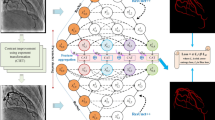Abstract
The narrowed area of coronary arteries is a common cardiovascular disease (CVD). Accurate computer-assisted treatment can find the location of the narrowed area in time and reduce the patient’s life risk. This article designed a deeper residual U-Net and added the Efficient Channel Attention (ECA) module to segment Computed Tomography Angiography (CTA) images. The network is called ECA-UNet. ECA module can implement cross-channel interaction without dimensionality reduction. During our experiment, choosing an adaptive kernel size for the ECA module can effectively improve the network’s performance. Experimental results proved that after selecting the adaptive cross-channel interaction coverage, the Intersection over Union (Iou) score of ECA-UNet on the testing set reaches 94.29%. Compared with other models in medical image segmentation, there is a pronounced improvement. For the segmented results, use the Ray-casting algorithm to reconstruct the three-dimensional coronary arteries, the narrowed area of the coronary artery can be clearly and intuitively observed from the reconstructed model.








Similar content being viewed by others
References
Benjamin, E.J., et al.: Heart disease and stroke statistics-2019 update: a report from the American heart association. Circulation 139(10), e56–e528 (2019)
Gohmann, R.F., et al.: Combined coronary CT-angiography and Tavi-planning: a contrast-neutral routine approach for ruling-out significant coronary artery disease. J. Clin. Med. 9(6), 1623 (2020)
Ronneberger, O., et al.: U-net: convolutional networks for biomedical image segmentation. In: International Conference on Medical Image Computing and Computer-assisted Intervention, Springer, pp. 234–241 (2015)
Zhou, Z., et al.: Unet++: a nested u-net architecture for medical image segmentation. In: Deep Learning in Medical Image Analysis and Multimodal Learning for Clinical Decision Support. Springer, pp. 3–11 (2018)
Gu, Z., Cheng, J., et al.: Ce-net: Context encoder network for 2d medical image segmentation. IEEE Trans. Med. Imaging 38(10), 2281–2292 (2019)
Jin, Q., Zo, Meng: Dunet: a deformable network for retinal vessel segmentation. Knowl.-Based Syst. 178, 149–162 (2019)
Jha, D., et al.: Doubleu-net: a deep convolutional neural network for medical image segmentation. In: 2020 IEEE 33rd International Symposium on Computer-based Medical Systems (CBMS), IEEE, pp 558–564 (2020)
He, K., Zhang, X., et al.: Deep residual learning for image recognition. In: Proceedings of the IEEE Conference on Computer Vision and Pattern Recognition, pp. 770–778 (2016)
Wang, Q., Wu, B., et al.: Eca-net: efficient channel attention for deep convolutional neural networks. In: 2020 IEEE/CVF Conference on Computer Vision and Pattern Recognition (CVPR), IEEE Computer Society, pp. 11531–11539 (2020)
Martinez-Perez, M., et al.: Segmentation of blood vessels from red-free and fluorescein retinal images. Med. Image Anal. 11(1), 47–61 (2007)
Kerkeni, A., et al.: A coronary artery segmentation method based on multiscale analysis and region growing. Comput. Med. Imaging Graph. 48, 49–61 (2016)
Kjerland, Ø.: Segmentation of Coronary Arteries from Ct-scans of the Heart Using Deep Learning. Master’s thesis, NTNU (2017)
Chen, Y.C., et al.: Coronary artery segmentation in cardiac CT angiography using 3D multi-channel u-net. arXiv preprint arXiv:1907.12246 (2019)
Tian, F., et al.: Automatic coronary artery segmentation algorithm based on deep learning and digital image processing. Appl. Intell. 51(12), 8881–8895 (2021)
Zhang, Z., et al.: Road extraction by deep residual u-net. IEEE Geosci. Remote Sens. Lett. 15(5), 749–753 (2018)
Han, G., Zhang, M., Wu, W., et al.: Improved u-net based insulator image segmentation method based on attention mechanism. Energy Rep. 7, 210–217 (2021)
Chaurasia, A., et al.: Linknet: exploiting encoder representations for efficient semantic segmentation. In: 2017 IEEE Visual Communications and Image Processing (VCIP), IEEE, pp. 1–4 (2017)
Dumoulin, V., et al.: A guide to convolution arithmetic for deep learning. arXiv preprint arXiv:1603.07285 (2016)
Hu, J., et al.: Squeeze-and-excitation networks. In: Proceedings of the IEEE Conference on Computer Vision and Pattern Recognition, pp. 7132–7141 (2018)
Ni, Z.L., et al.: Raunet: residual attention u-net for semantic segmentation of cataract surgical instruments. In: International Conference on Neural Information Processing, Springer, pp. 139–149 (2019)
Yao, Z., Xie, W., Zhang, J., et al.: Imagetbad: a 3D computed tomography angiography image dataset for automatic segmentation of type-b aortic dissection. Front. Physiol. 12 (2021)
Levoy, M.: Display of surfaces from volume data. IEEE Comput. Graph. Appl. 8(3), 29–37 (1988)
Li, Z., Zhang, J.: Study on volume rendering of CT slices based on ray casting. In: 2010 3rd International Conference on Computer Science and Information Technology, IEEE, pp. 157–160 (2010)
Author information
Authors and Affiliations
Corresponding author
Ethics declarations
Funding
Tianjin Science and Technology Program (19PTZWHZ000 20); National Natural Science Foundation of China (61872269, 619032 73, 62072335).
Availability of data and materials
The data that support the findings of this study are available on request from the corresponding author.
Additional information
Publisher's Note
Springer Nature remains neutral with regard to jurisdictional claims in published maps and institutional affiliations.
Rights and permissions
About this article
Cite this article
Duan, X., Sun, Y. & Wang, J. ECA-UNet for coronary artery segmentation and three-dimensional reconstruction. SIViP 17, 783–789 (2023). https://doi.org/10.1007/s11760-022-02288-y
Received:
Revised:
Accepted:
Published:
Issue Date:
DOI: https://doi.org/10.1007/s11760-022-02288-y





